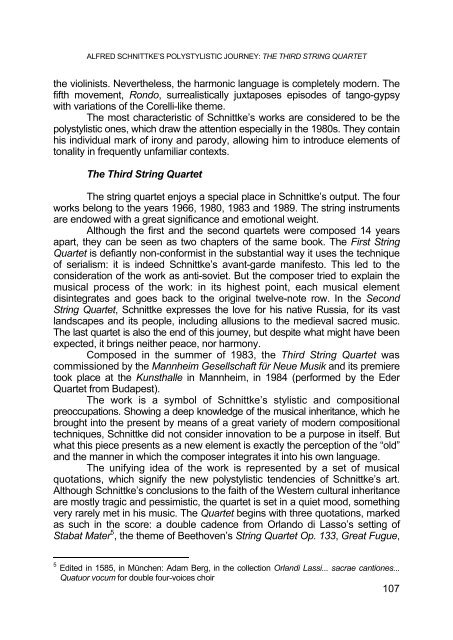musica - Studia
musica - Studia
musica - Studia
You also want an ePaper? Increase the reach of your titles
YUMPU automatically turns print PDFs into web optimized ePapers that Google loves.
ALFRED SCHNITTKE’S POLYSTYLISTIC JOURNEY: THE THIRD STRING QUARTET<br />
the violinists. Nevertheless, the harmonic language is completely modern. The<br />
fifth movement, Rondo, surrealistically juxtaposes episodes of tango-gypsy<br />
with variations of the Corelli-like theme.<br />
The most characteristic of Schnittke’s works are considered to be the<br />
polystylistic ones, which draw the attention especially in the 1980s. They contain<br />
his individual mark of irony and parody, allowing him to introduce elements of<br />
tonality in frequently unfamiliar contexts.<br />
The Third String Quartet<br />
The string quartet enjoys a special place in Schnittke’s output. The four<br />
works belong to the years 1966, 1980, 1983 and 1989. The string instruments<br />
are endowed with a great significance and emotional weight.<br />
Although the first and the second quartets were composed 14 years<br />
apart, they can be seen as two chapters of the same book. The First String<br />
Quartet is defiantly non-conformist in the substantial way it uses the technique<br />
of serialism: it is indeed Schnittke’s avant-garde manifesto. This led to the<br />
consideration of the work as anti-soviet. But the composer tried to explain the<br />
<strong>musica</strong>l process of the work: in its highest point, each <strong>musica</strong>l element<br />
disintegrates and goes back to the original twelve-note row. In the Second<br />
String Quartet, Schnittke expresses the love for his native Russia, for its vast<br />
landscapes and its people, including allusions to the medieval sacred music.<br />
The last quartet is also the end of this journey, but despite what might have been<br />
expected, it brings neither peace, nor harmony.<br />
Composed in the summer of 1983, the Third String Quartet was<br />
commissioned by the Mannheim Gesellschaft für Neue Musik and its premiere<br />
took place at the Kunsthalle in Mannheim, in 1984 (performed by the Eder<br />
Quartet from Budapest).<br />
The work is a symbol of Schnittke’s stylistic and compositional<br />
preoccupations. Showing a deep knowledge of the <strong>musica</strong>l inheritance, which he<br />
brought into the present by means of a great variety of modern compositional<br />
techniques, Schnittke did not consider innovation to be a purpose in itself. But<br />
what this piece presents as a new element is exactly the perception of the “old”<br />
and the manner in which the composer integrates it into his own language.<br />
The unifying idea of the work is represented by a set of <strong>musica</strong>l<br />
quotations, which signify the new polystylistic tendencies of Schnittke’s art.<br />
Although Schnittke’s conclusions to the faith of the Western cultural inheritance<br />
are mostly tragic and pessimistic, the quartet is set in a quiet mood, something<br />
very rarely met in his music. The Quartet begins with three quotations, marked<br />
as such in the score: a double cadence from Orlando di Lasso’s setting of<br />
Stabat Mater 5 , the theme of Beethoven’s String Quartet Op. 133, Great Fugue,<br />
5 Edited in 1585, in München: Adam Berg, in the collection Orlandi Lassi... sacrae cantiones...<br />
Quatuor vocum for double four-voices choir<br />
107

















